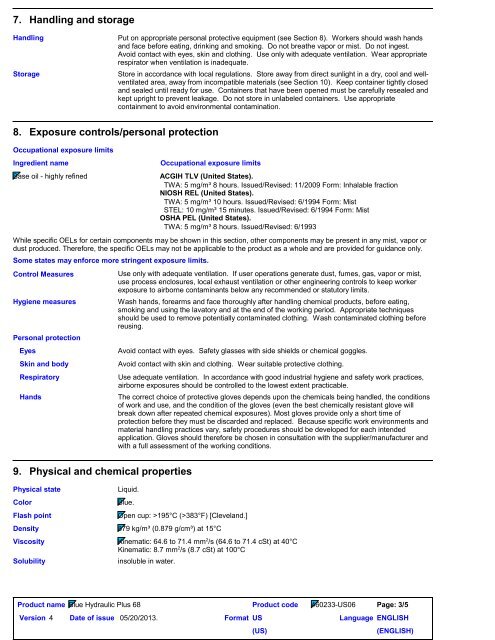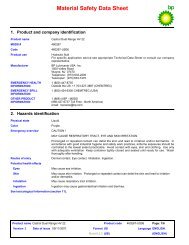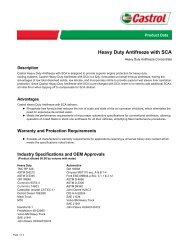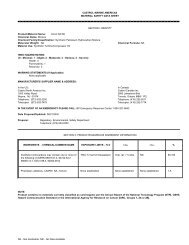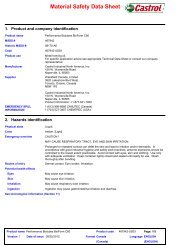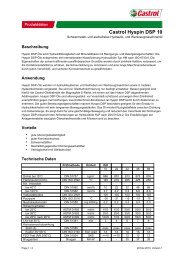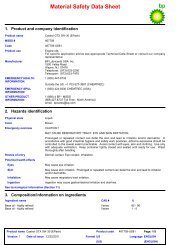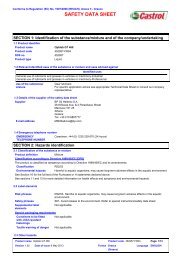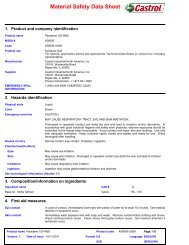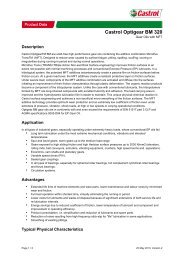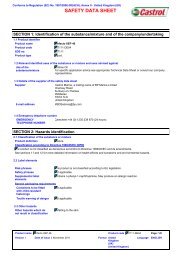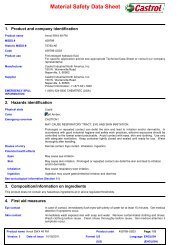(US)213935Blue Hydraulic Plus 68.pdf - Castrol
(US)213935Blue Hydraulic Plus 68.pdf - Castrol
(US)213935Blue Hydraulic Plus 68.pdf - Castrol
- No tags were found...
You also want an ePaper? Increase the reach of your titles
YUMPU automatically turns print PDFs into web optimized ePapers that Google loves.
7. Handling and storageHandlingStoragePut on appropriate personal protective equipment (see Section 8). Workers should wash handsand face before eating, drinking and smoking. Do not breathe vapor or mist. Do not ingest.Avoid contact with eyes, skin and clothing. Use only with adequate ventilation. Wear appropriaterespirator when ventilation is inadequate.Store in accordance with local regulations. Store away from direct sunlight in a dry, cool and wellventilatedarea, away from incompatible materials (see Section 10). Keep container tightly closedand sealed until ready for use. Containers that have been opened must be carefully resealed andkept upright to prevent leakage. Do not store in unlabeled containers. Use appropriatecontainment to avoid environmental contamination.8. Exposure controls/personal protectionOccupational exposure limitsIngredient nameBase oil - highly refinedSome states may enforce more stringent exposure limits.Occupational exposure limitsACGIH TLV (United States).TWA: 5 mg/m³ 8 hours. Issued/Revised: 11/2009 Form: Inhalable fractionNIOSH REL (United States).TWA: 5 mg/m³ 10 hours. Issued/Revised: 6/1994 Form: MistSTEL: 10 mg/m³ 15 minutes. Issued/Revised: 6/1994 Form: MistOSHA PEL (United States).TWA: 5 mg/m³ 8 hours. Issued/Revised: 6/1993While specific OELs for certain components may be shown in this section, other components may be present in any mist, vapor ordust produced. Therefore, the specific OELs may not be applicable to the product as a whole and are provided for guidance only.Control MeasuresHygiene measuresPersonal protectionEyesSkin and bodyRespiratoryHandsUse only with adequate ventilation. If user operations generate dust, fumes, gas, vapor or mist,use process enclosures, local exhaust ventilation or other engineering controls to keep workerexposure to airborne contaminants below any recommended or statutory limits.Wash hands, forearms and face thoroughly after handling chemical products, before eating,smoking and using the lavatory and at the end of the working period. Appropriate techniquesshould be used to remove potentially contaminated clothing. Wash contaminated clothing beforereusing.Avoid contact with eyes. Safety glasses with side shields or chemical goggles.Avoid contact with skin and clothing. Wear suitable protective clothing.Use adequate ventilation. In accordance with good industrial hygiene and safety work practices,airborne exposures should be controlled to the lowest extent practicable.The correct choice of protective gloves depends upon the chemicals being handled, the conditionsof work and use, and the condition of the gloves (even the best chemically resistant glove willbreak down after repeated chemical exposures). Most gloves provide only a short time ofprotection before they must be discarded and replaced. Because specific work environments andmaterial handling practices vary, safety procedures should be developed for each intendedapplication. Gloves should therefore be chosen in consultation with the supplier/manufacturer andwith a full assessment of the working conditions.9.Physical and chemical propertiesPhysical stateColorFlash pointDensityLiquid.Blue.Open cup: >195°C (>383°F) [Cleveland.]879 kg/m³ (0.879 g/cm³) at 15°CViscosity Kinematic: 64.6 to 71.4 mm 2 /s (64.6 to 71.4 cSt) at 40°CKinematic: 8.7 mm 2 /s (8.7 cSt) at 100°CSolubilityinsoluble in water.Product name Blue <strong>Hydraulic</strong> <strong>Plus</strong> 68Product code 460233-<strong>US</strong>06Version 4 Date of issue 05/20/2013.Format <strong>US</strong>Language(<strong>US</strong>)Page: 3/5ENGLISH(ENGLISH)


